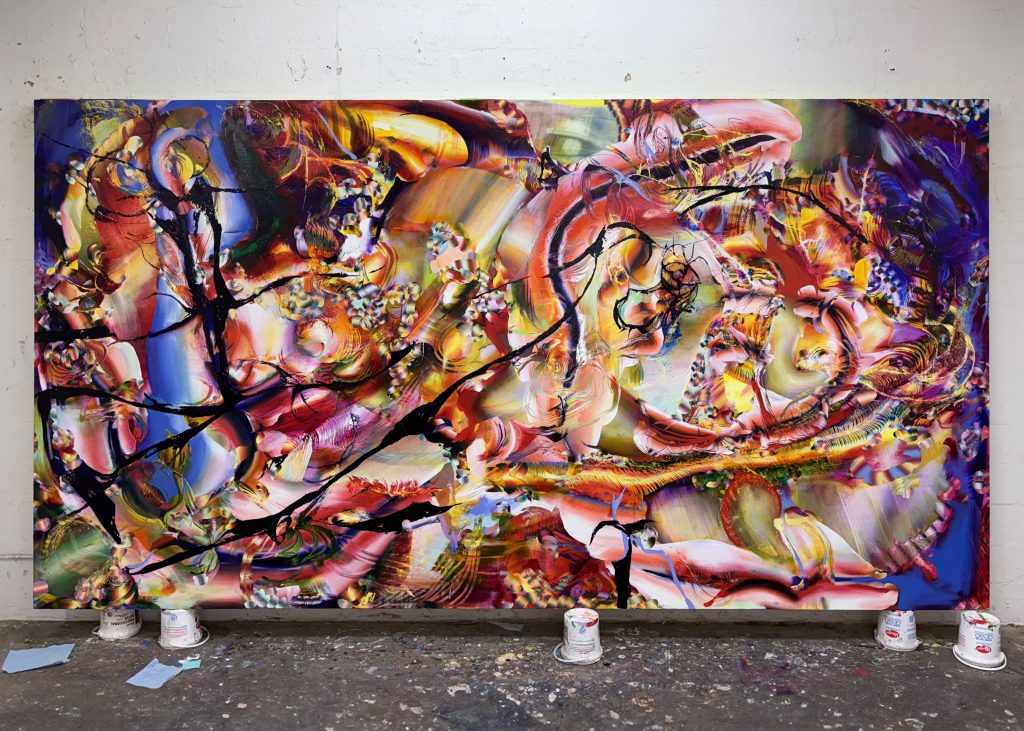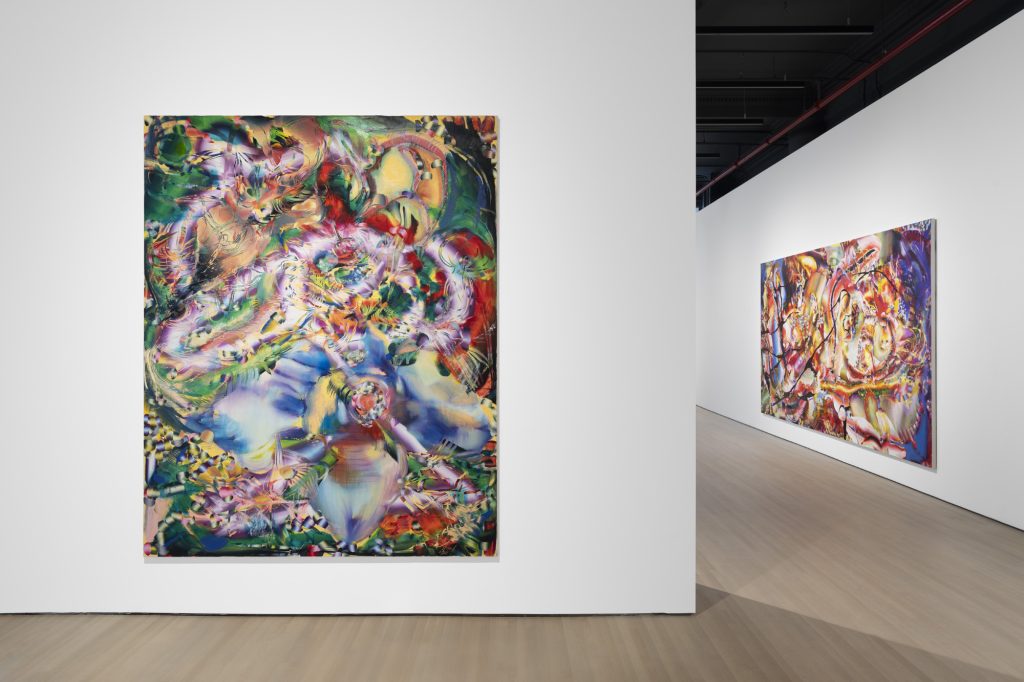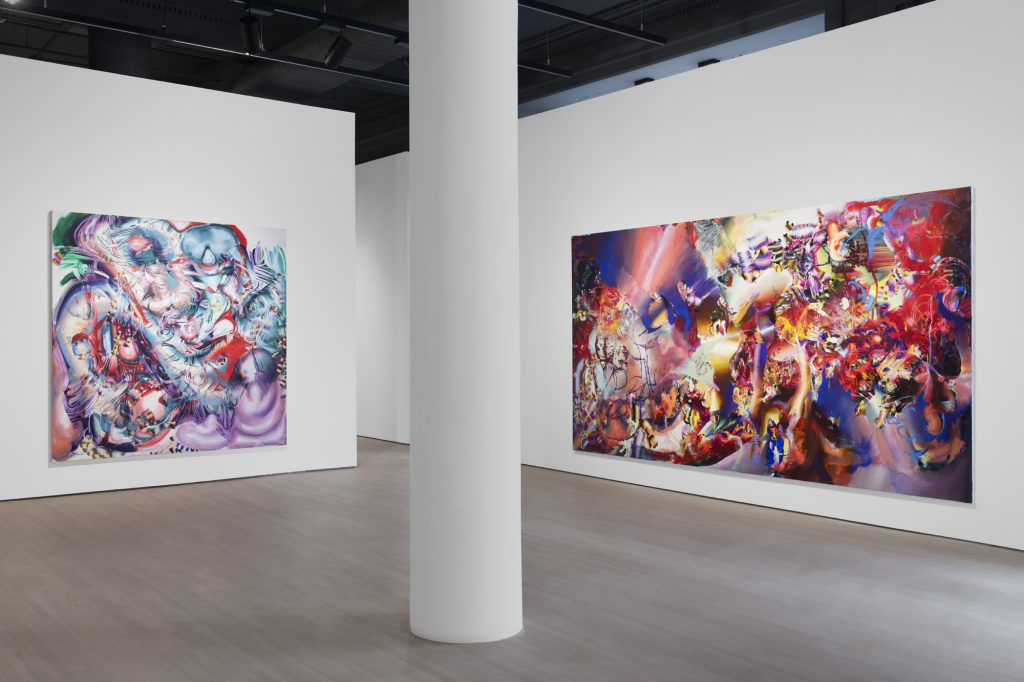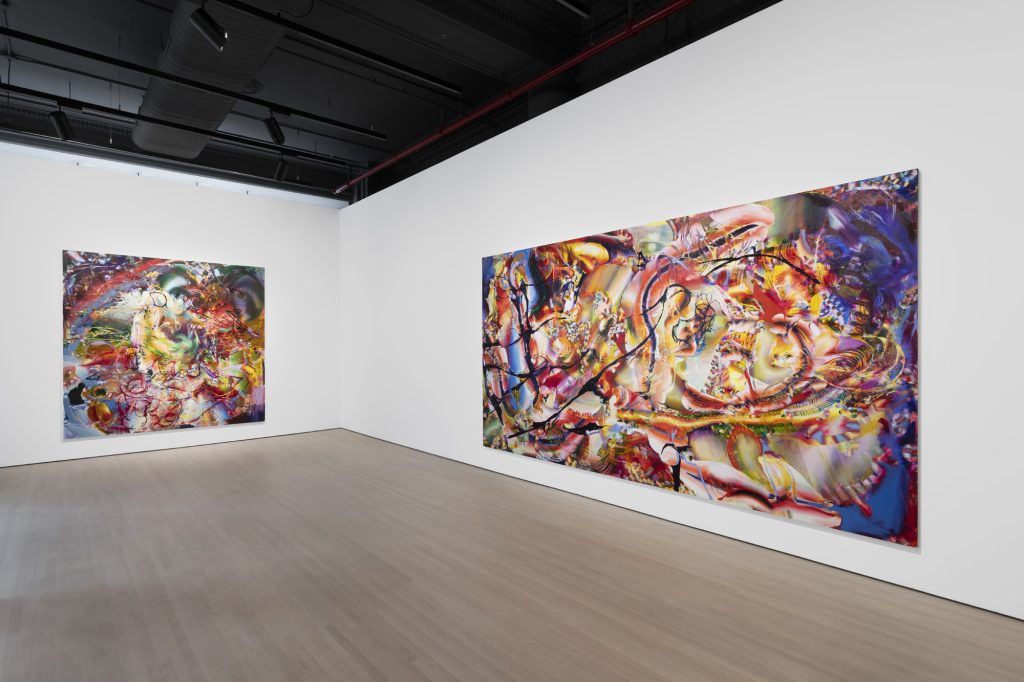125 Newbury was one of the first art galleries that I visited in New York City, seeing a Dec. 2022-Jan. 2023 exhibition of artist Ryan Sullivan, which happened to, in turn, be one of the first exhibitions held there at all. Whether sculptor Lynda Benglis, photographer Peter Hujar, or multimedia artist Jim Dine, their exhibitions tend to reshape how I think about the possibilities of art each and every time, and that trend continues with “Logopanic,” the new exhibition — closing mere days from now — of Lauren Quin, who’s based in Los Angeles.
The Logistics of Quin’s Work
Quin’s paintings are massive to the point that it’s no wonder the exhibition had two parts, with a new rotation of work in its concluding weeks. A piece that shares the name of the show is 15 feet wide. How often do you see a painting that expansive? They’re out there, of course, but even the size alone is a draw.
Striking a slightly different tone each time, whether moderated by changes in color palette or the particular assemblage of perceptible shapes, Quin’s paintings all utilize a panoply of color-applying gestures that, in theory, you could trace with your eye indefinitely. They’re snaking, pulsing, shimmering, and shattering masses of color constructed with form after form built on top of each other, though you get the idea that Quin is focusing on the intangible, suggested qualities of these forms rather than a strictly defined set of logistics, keeping colors and shape in line to advance broader horizons.
One important specific is that many of the crackles of color are relatively small, meaning it takes a lot of multiplying to reach the edges of the canvas and fill out the piece, giving plenty of space for intensifying energy. When you’re standing before Quin’s work, the colors wash over you with ranges of hue that pop each and every time. “Logopanic” (2024), for instance, features cascading tidal waves of red meshing with (among much more) forms reminding me of images I’ve seen of neurological systems.
(The below image features an apparent iteration of the painting. I’m not sure if it’s complete in the depiction.)

Making the Intangible, Present
On my second visit (to the latter rotation of work), I was struck by how Quin managed to suggest real senses of physical depth — and meaningful emotional presence — with forms that could come across strictly two-dimensional. But the contrast in color tones included in some portions helped give Quin’s work physical heft.
To use “Logopanic” (meaning the painting in particular) as a reference point again, Quin nestles cascades of shimmering, shifting blue alongside streaking flashes of more heated color, and I had the perceptual sense that these contrasting areas of color were in different physical places within the given painting’s world. They bounce off each other, pushing apart on the surface.
Here and across the exhibition, Quin seemed to capture physical space that ventured outside of the confines of three dimensions.
It’s not something we can fully see with our built-in systems of perception, but she visually brings forth the concept, because these pieces clearly exist somewhere in a meaningfully physical strata of experience, but they don’t resemble the three-dimensional world. I was thinking about what it would be like if my memories of a particular fireworks show (the vibrant color in Quin’s exhibition made that an easy testing ground) had somehow drifted into pieces and been turned inside out in a process that remained unfolding before me as I watched.
It’s a combination of the tangible side of experiencing a place and the often shifting experience in the mind, bringing the two into harmony. What it’s like to be somewhere isn’t dependent only on its physical contours, instead impacted by subliminal bursts from the metaphorical, psychological ground, arriving from sometimes unknown origins but adding feeling — sometimes destabilizing — to your journey through a place. So from one vantage point, it’s like Quin made the invisible into something visible. What’s left when you close your eyes is now on a canvas.

Contrast, Energy, and Indeterminate Transit
Quin’s sharply jolting forms often rocket right past you, in a physical sense and a mental or experiential one.
The ample contrast in Quin’s form and color steeps the exhibition in physical energy. Everything that we’re seeing looks like it’s going somewhere, though there’s rarely if ever a moment of precise, familiar clarity.
But there’s a sense of purpose married to artfully difficult directional choices. You’re in a real, fleshed out place, though left without clearly seeing whatever is transpiring at the topmost level. Quin makes artistic control evident on the surfaces of these images but also subsumes it, balancing the personal with a looming expanse of experience. She presents the concept of aesthetic seams and what they signify and then explodes it. Streaks of enlivened and enlivening color go flying in perpetuity. Snapshots intermingle and dissolve, endlessly circulating.
The massive size of these works combined with the actual contours of some of the shapes also made Quin’s paintings look, at times, like portals. You don’t really know where they’re headed, though. It’s more like stepping into — or falling into — a dream, where a mesmerizing but slightly blinding flash of time combines with that expanse of experience that feels like it goes on forever.
“Logopanic” featuring artist Lauren Quin continues at 125 Newbury through the end of this week, June 15.

Featured image: Lauren Quin: Logopanic
395 Broadway, New York, NY 10013
May 3 – June 15, 2024
Photography courtesy Peter Clough
You may also like
-
Diana Kurz at Lincoln Glenn in New York: A Review of a Shining Art Exhibition
-
Dustin Hodges at 15 Orient in New York City: An Ensnaring Exhibition at an Exciting Gallery
-
Maren Hassinger at Susan Inglett Gallery in New York: Reviewing an Uplifting Art Exhibition
-
Enzo Shalom at Bortolami in New York City: Reviewing an Entrancing Exhibition of Paintings
-
“Ben Werther: Townworld” at Amanita in New York City: Reviewing a Richly Memorable Art Exhibition
